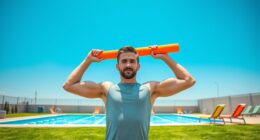Looking for a great workout guide for infinity pools? This plan offers 12 water exercises that boost cardio, strengthen muscles, improve flexibility, and enhance balance—all with low impact. You’ll learn moves like water jogging, aqua squats, pool planks, and arm circles, perfect for all fitness levels. These exercises leverage water’s resistance to maximize effort while protecting your joints. Keep exploring to find out how these moves can transform your aquatic workouts and keep you motivated.
Key Takeaways
- The guide features 12 water exercises ideal for infinity pools, emphasizing low-impact, full-body, and resistance training.
- Exercises include water jogging, jumping jacks, squats, planks, and shoulder stretches, suitable for all fitness levels.
- Focus areas are cardiovascular health, strength, stability, flexibility, and balance, enhanced by water’s natural resistance.
- The exercises require no equipment, utilizing water buoyancy and resistance for effective workouts.
- The guide incorporates AI-driven analytics for progress tracking and workout optimization in an aquatic environment.
Water Jogging for Cardio Strength

Water jogging is an excellent low-impact exercise that boosts your cardio strength while reducing stress on your joints. As you jog through the water, the resistance from the pool forces your muscles to work harder, enhancing your endurance. The buoyancy support minimizes impact, making it perfect if you’re recovering from injury or want to avoid joint strain. You can adjust the intensity by increasing your pace or adding arm movements. Keep your posture upright and engage your core to maximize benefits. Water jogging also helps improve your cardiovascular health and stamina without the usual wear and tear on your body. Since it’s accessible and adaptable, it’s an ideal workout to incorporate into your routine for overall fitness and stress relief. Additionally, incorporating AI-driven analytics can help track your progress and optimize your workout intensity over time.
Aqua Squats to Build Leg Power
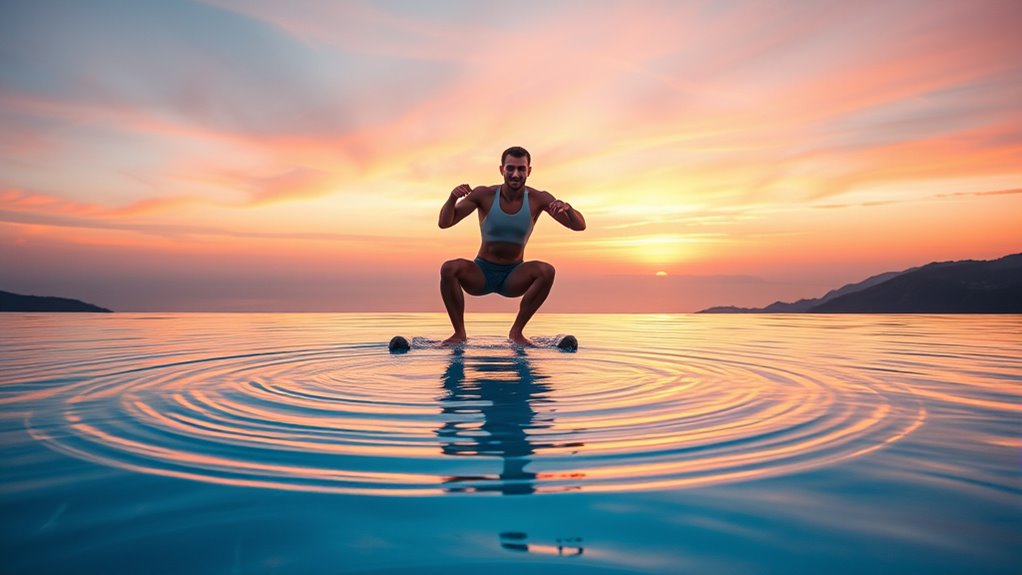
To get the most out of aqua squats, focus on proper technique by keeping your back straight and knees aligned with your toes. You can increase the challenge by adding variations like jump squats or holding weights. Experimenting with these options helps build leg strength effectively while keeping your workout engaging. Additionally, incorporating safe workout practices ensures that your exercise routine remains effective and minimizes the risk of injury.
Proper Technique Tips
Mastering proper technique is essential for maximizing the benefits of aqua squats and preventing injury. Begin by standing with your feet shoulder-width apart, knees slightly bent, and core engaged. Keep your back straight and gaze forward. As you squat, push your hips back and bend your knees, ensuring they track over your toes. Maintain contact with the pool floor or water at waist or chest level, depending on comfort. Don’t let your knees cave inward or shift outward; stay aligned. Lower yourself until your thighs are parallel to the water’s surface, then push through your heels to stand back up. Control your movement throughout, avoiding rushing or jerky motions. Proper technique ensures effective muscle engagement and reduces strain on joints. Additionally, adjusting your water depth can influence resistance and the effectiveness of the exercise.
Variations for Challenge
Adding variations to your aqua squats can considerably increase their challenge and help you build greater leg power. One effective way is to increase your squat depth, going lower to engage more muscles. You can also try single-leg aqua squats, which demand more balance and strength, targeting stabilizer muscles. Incorporate explosive upward movements to boost power and speed. Using ankle weights or resistance bands enhances resistance, making your muscles work harder. Another variation is to perform slow, controlled squats to focus on muscle engagement and form. Elevate your heels or toes by standing on a submerged platform or using buoyancy aids to target different parts of your legs. These modifications keep your workout dynamic, maximize muscle activation, and accelerate your progress. Engaging in balance exercises during your water workout can further improve stability and overall strength.
Pool Plank for Core Stability
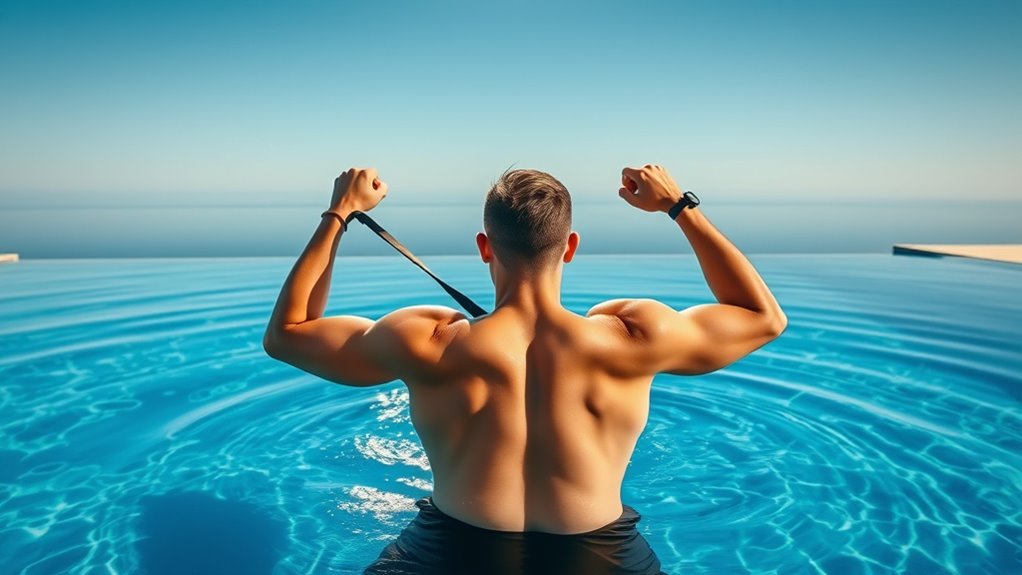
Have you ever considered how the water’s resistance can enhance your core workout? The pool plank is an effective move that targets your abs, back, and shoulders while engaging your entire core. To do it, find a stable spot in the water, like near the pool edge, and hold yourself in a forearm plank position with your body straight. Keep your hips level and avoid sagging or piking. The water’s resistance makes maintaining this posture more challenging, forcing your core muscles to work harder. Breathe steadily, focusing on keeping your core tight. This exercise not only improves stability but also enhances muscular endurance. Incorporating home decoration inspiration into your workout space can motivate you further to stay consistent. Incorporate pool planks into your routine to build a stronger, more balanced core while enjoying the soothing water environment.
Leg Kicks for Lower Body Toning

Are you looking for an effective way to tone your lower body? Leg kicks in the water are perfect for targeting your thighs, hips, and glutes. Stand near the edge of the pool, hold onto it for support, and kick one leg straight back, keeping your core engaged. Switch legs smoothly, focusing on controlled movements. The resistance of the water makes your muscles work harder without putting stress on your joints. As you kick, guarantee your movements are steady and deliberate to maximize toning benefits. Incorporate different angles—lateral, front, or back kicks—to target various muscle groups. This exercise boosts strength and endurance while providing a low-impact workout. Consistent leg kicks will help you achieve a leaner, more toned lower body. Regular practice can also enhance muscle engagement, leading to better results over time.
Arm Circles for Shoulder Mobility

To get the most out of arm circles, focus on keeping your arms properly positioned with a slight bend at the elbows. Use controlled, smooth movements to avoid strain and maximize effectiveness. This exercise helps improve shoulder flexibility and mobility, making daily movements easier. Incorporating proper technique ensures safety and enhances the benefits of the exercise.
Proper Arm Positioning
Proper arm positioning is essential for maximizing the benefits of arm circles and preventing injury. Keep your arms extended straight out to the sides, shoulder height, with palms facing downward. Avoid letting your shoulders shrug or lift; instead, relax and keep them down away from your ears. Maintain a slight bend in your elbows to reduce joint strain. Engage your core to support your posture and prevent leaning forward or backward. Move your arms in controlled, smooth circles, focusing on consistent motion. Keep your movements symmetrical, ensuring both arms follow the same path. Proper positioning ensures full shoulder engagement, improves mobility, and minimizes the risk of overstretching or joint strain during your water exercise routine. Additionally, adopting innovative sustainable materials can enhance your workout experience while supporting eco-friendly practices.
Controlled Movement Techniques
Controlled movement techniques are key to maximizing shoulder mobility during arm circles. By moving your arms deliberately and smoothly, you prevent unnecessary strain and guarantee effective stretching. Focus on maintaining a steady pace, avoiding jerky or rapid motions. Keep your movements intentional, with consistent speed and controlled acceleration or deceleration. This helps activate stabilizing muscles and improves joint flexibility. To enhance control, engage your core and keep your shoulders relaxed. Pay attention to your breathing—inhale as you prepare, exhale as you circle your arms. Maintaining control throughout each rotation minimizes the risk of injury and promotes better range of motion. Remember, quality over speed is essential for getting the most benefit from your water-based shoulder exercises. Incorporating specialized planters can also support your indoor gardening, adding to your overall wellness routine.
Benefits for Shoulder Flexibility
Incorporating arm circles into your routine considerably enhances shoulder flexibility by gently stretching the joint and surrounding muscles. This simple movement targets the shoulder’s range of motion, helping to loosen tightness and prevent stiffness. As you perform arm circles in water, the resistance provides a controlled environment, making it easier to maintain proper form. Regular practice increases joint mobility, allowing you to move your arms more freely and comfortably. Improved shoulder flexibility also reduces the risk of strains and injuries, especially during other exercises or daily activities. Plus, the buoyant water supports your movements, minimizing strain on delicate structures. Over time, you’ll notice greater ease in reaching overhead, behind your back, or across your chest, boosting overall shoulder health and function. Additionally, water exercises can help manage pregnancy symptoms like back pain and swelling, making them a safe option during pregnancy.
Water Lunges for Balance and Strength
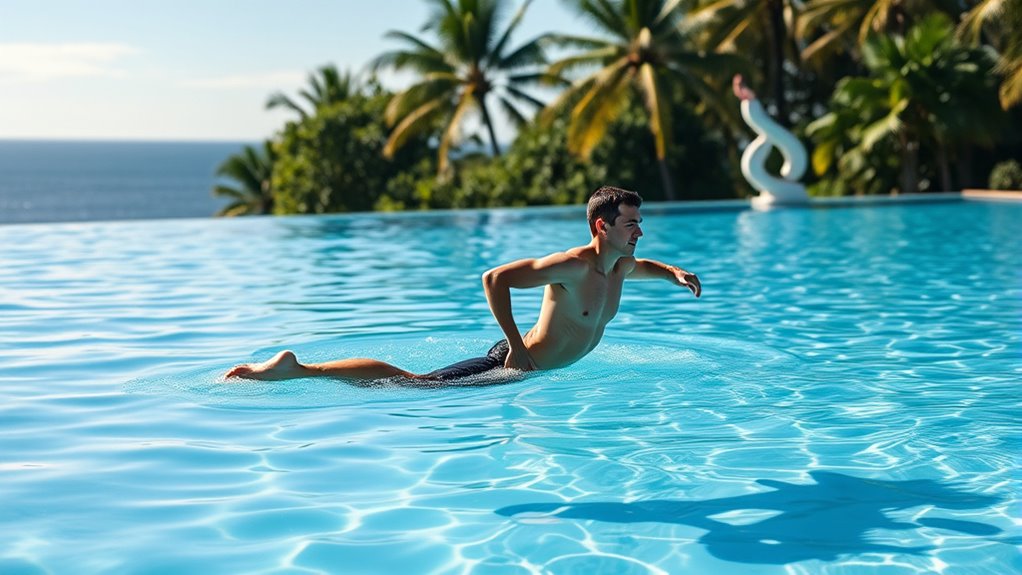
Water lunges are an excellent way to boost both your balance and strength simultaneously. By performing lunges in the water, you add resistance that challenges your muscles and helps improve stability. As you step forward into a lunge, the water pushes back against your leg, engaging your core and leg muscles more effectively than on land. Keep your movements controlled to maximize benefits and prevent injury. Maintaining proper posture is essential; keep your back straight and knees aligned over your toes. The buoyancy reduces joint stress, making this exercise suitable for all fitness levels. Incorporate water lunges into your routine to develop stronger, more balanced legs while enhancing overall coordination in a low-impact environment.
Treading Water for Endurance

Have you ever wondered how to boost your cardiovascular endurance while minimizing joint impact? Treading water is perfect for that. It engages your core, legs, and arms simultaneously, building stamina without stress on your joints. Imagine yourself in the pool, maintaining a stable, upright position, legs kicking gently, arms moving steadily. To visualize, picture:
| Body Position | Movement Focus | Result |
|---|---|---|
| Upright, vertical | Steady kicks | Improves endurance |
| Arms paddling | Continuous arm movement | Boosts cardiovascular health |
| Legs kicking | Consistent flutter | Strengthens leg muscles |
This exercise mimics a natural, continuous motion, making it effective and safe for all fitness levels. Keep your movements controlled, breathe steadily, and you’ll increase your stamina effortlessly.
Water Push-Ups for Upper Body Strength
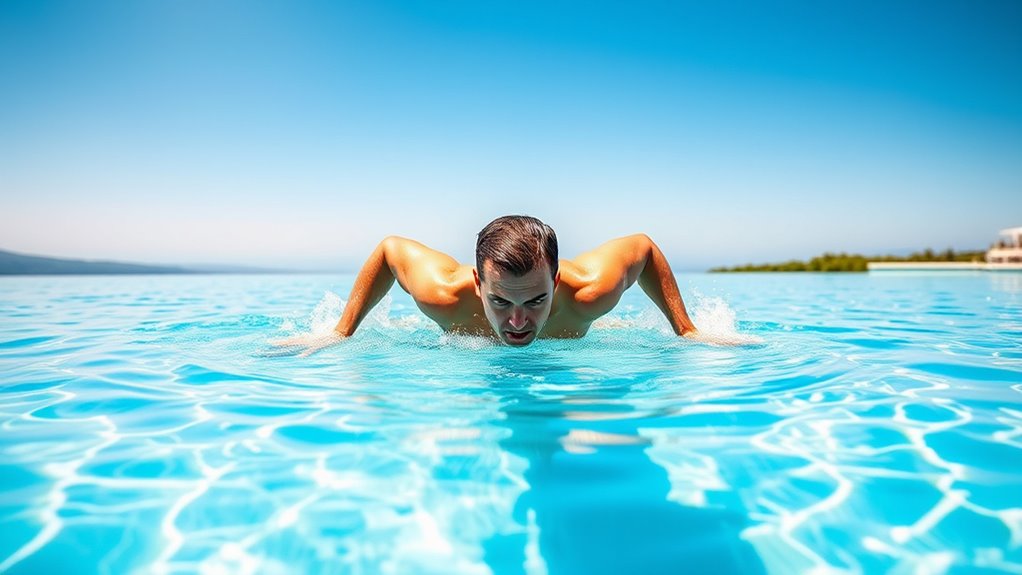
Performing push-ups in water provides an effective way to build upper body strength while reducing joint stress. Water resistance challenges your muscles more than traditional push-ups, helping you develop power and endurance. To do them, stand facing the pool wall with your hands placed shoulder-width apart on the edge. Keep your body straight and core engaged, then lower yourself toward the water, bending your elbows. Push back up until your arms are extended. The water’s resistance forces your muscles to work harder, increasing strength without putting pressure on your joints. This exercise also improves stability and balance, making it perfect for all fitness levels. Incorporate water push-ups into your routine to enhance upper body strength safely and effectively in the pool.
Cross-Body Water Twists for Oblique Muscles
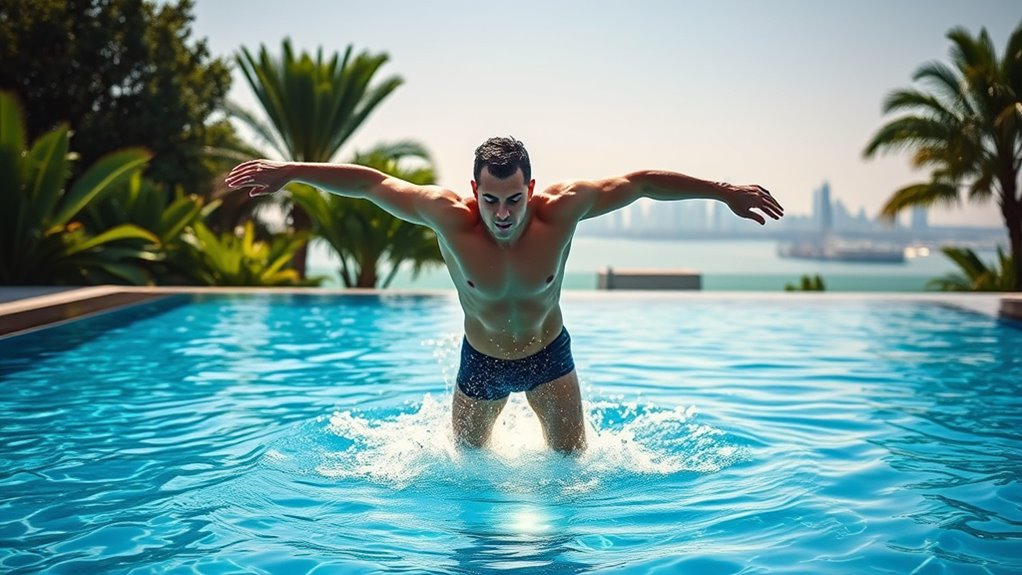
Cross-body water twists are great for engaging your core through rotational movement. They help improve oblique strength and stability with each controlled twist. Incorporate these into your routine to boost overall core power and mobility.
Engaging Core Rotation
Engaging your oblique muscles through core rotation exercises like Cross-Body Water Twists effectively targets the side abdominal muscles and enhances overall rotational strength. To maximize engagement:
- Stand with feet shoulder-width apart in the pool, holding your hands together at chest level.
- Rotate your torso to one side, twisting from the waist while keeping hips stable.
- Hold briefly, feeling the oblique muscles engage, then rotate to the opposite side.
- Maintain controlled movements, focusing on smooth twists rather than speed, to activate the core muscles effectively.
This exercise not only strengthens your obliques but also improves your balance and stability in water. Incorporate these twists regularly to develop a more resilient, rotational core that supports functional movements both in and out of the pool.
Enhancing Oblique Strength
To effectively strengthen your oblique muscles, incorporating Cross-Body Water Twists into your routine is highly beneficial. Stand in the pool with your feet shoulder-width apart, holding a water-safe weight or just using your hands. Twist your torso to one side, bringing your hand or weight across your body toward the opposite hip. Keep your core engaged and move smoothly through the motion. Then, rotate to the other side, maintaining control and steady breathing. This exercise targets your obliques by encouraging rotational movement, helping to build strength and stability. Perform 2-3 sets of 12-15 twists per side for *ideal* results. The resistance of the water makes the exercise challenging yet low-impact, *perfect* for enhancing oblique muscles safely and effectively.
Flutter Kicks for Core and Hip Flexors
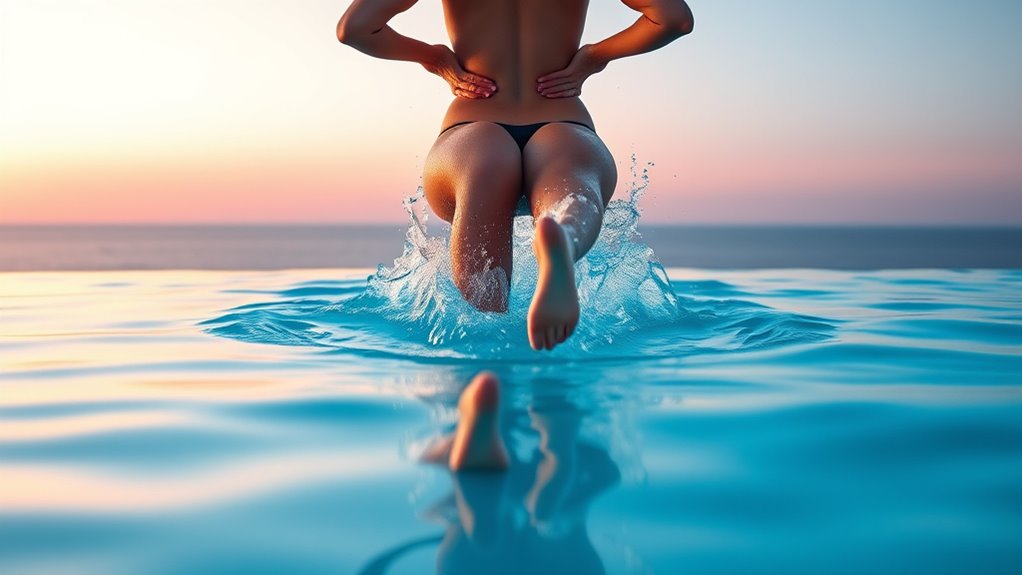
Have you ever wondered how to effectively strengthen your core and hip flexors with a simple yet powerful move? Flutter kicks are exactly that. They target your lower abs and hip flexors while keeping you engaged in the water. To do them:
- Lie on your back, arms at your sides, and legs extended.
- Keep your legs straight and lift them slightly off the pool floor.
- Alternate small, quick kicks up and down, keeping your core tight.
- Maintain steady breathing and avoid arching your back.
This exercise enhances lower core stability, improves hip mobility, and develops endurance. You can do them for 30 seconds, rest, then repeat. Flutter kicks are perfect for infinity pools, allowing you to maximize resistance and minimize joint strain.
Side Leg Raises for Hip Stability

Side leg raises are an effective way to improve hip stability and strengthen the outer thigh muscles. To do this exercise, stand sideways in the pool, holding onto the edge for balance if needed. Keep your legs straight and lift the top leg slowly, focusing on engaging your hip muscles. Raise your leg to about hip height, then lower it with control. Keep your core tight and avoid leaning or twisting your torso. Repeat this movement for 10-15 repetitions, then switch sides. This exercise targets the gluteus medius and minimus, which are essential for hip stability and balance. Incorporating side leg raises into your water workout helps prevent injuries and improves overall hip function. Perform them consistently for noticeable strength gains and enhanced stability.
Jumping Jacks in the Pool for Full-Body Cardio
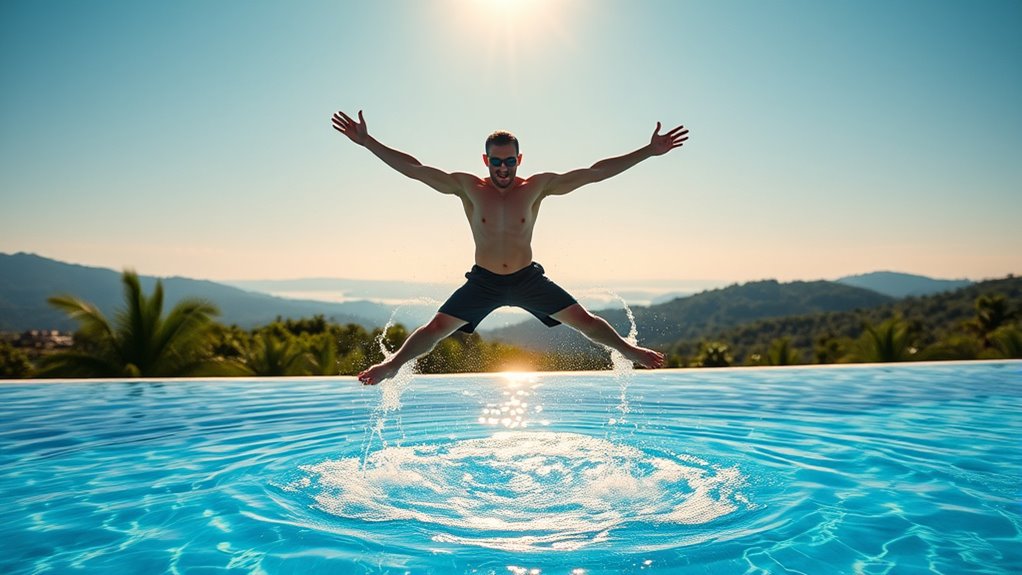
Jumping jacks in the pool offer an excellent way to boost your cardiovascular fitness while reducing impact on your joints. The water provides resistance, making your workout more effective without overstraining your body. To get started:
- Stand with feet together and arms at your sides in shallow water.
- Jump your feet outward while raising your arms overhead.
- Jump back to the starting position, bringing your feet together and arms down.
- Repeat quickly for 30-60 seconds, maintaining steady breathing.
This exercise works your entire body, elevates your heart rate, and improves coordination. The water’s resistance helps strengthen muscles while cushioning your joints. Incorporate jumping jacks into your routine for a fun, effective full-body cardio workout in your infinity pool.
Frequently Asked Questions
Can Water Exercises Help With Joint Pain Relief?
Yes, water exercises can help relieve joint pain. When you work out in water, the buoyancy reduces pressure on your joints, making movements easier and less painful. The resistance of water also helps strengthen muscles around your joints, providing better support. Plus, the soothing nature of water can decrease inflammation and stiffness. So, if you’re dealing with joint pain, incorporating water exercises into your routine can be a gentle, effective way to find relief.
What Are Safety Tips for Beginner Water Workouts?
To stay safe during beginner water workouts, always warm up before starting and listen to your body. Wear proper swimwear and consider using floatation devices if needed. Keep hydrated and avoid overexertion, especially in deep water. Never push yourself beyond your comfort zone, and always exercise with a buddy or under supervision. Follow these tips to enjoy a safe, effective, and enjoyable water workout experience.
How Often Should I Do Water Exercises for Best Results?
You should do water exercises at least five times a week for the best results, turning your routine into a powerful wave of fitness. Imagine your muscles strengthening and your stamina skyrocketing with every session, as if you’re riding a never-ending tide of energy. Consistency is key, so make it a daily habit—your body will thank you with increased strength, flexibility, and energy that feels like you can conquer any wave life throws your way.
Are Water Exercises Suitable for Pregnant Women?
Yes, water exercises are suitable for pregnant women because they reduce joint strain and provide support. You should always consult your healthcare provider before starting any new workout. Stick to gentle, low-impact movements, and avoid overheating. Water helps you stay active safely, easing pregnancy discomfort. Keep sessions moderate, around 20-30 minutes, and listen to your body to ensure comfort and safety during your pregnancy.
Can Water Workouts Improve Overall Flexibility?
Like a gentle breeze stretching across a calm lake, water workouts can markedly improve your overall flexibility. When you engage in water exercises, the resistance and buoyancy support your movements, allowing you to stretch further and reduce strain on your joints. Regularly practicing these exercises helps lengthen muscles, increase range of motion, and promote better posture. So, if you’re seeking a low-impact way to enhance flexibility, water workouts are an excellent choice.
Conclusion
Did you know water exercises can boost your metabolism and burn more calories than land workouts? With these 12 water exercises, you not only enhance strength and stability but also challenge your body in ways you never imagined. Incorporate them into your routine, and you might just find that water workouts are the secret to staying fit, healthy, and energized—proving the water’s power goes beyond just cooling you off. Plunge in and see the results for yourself!










